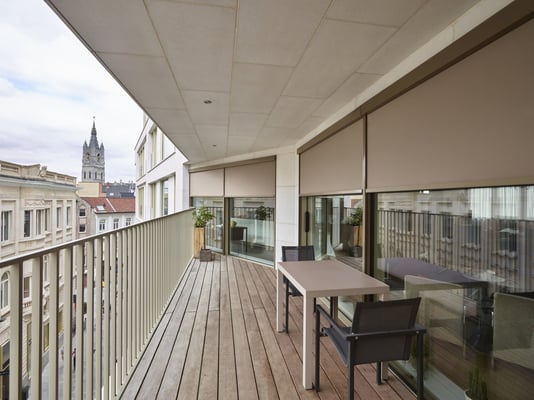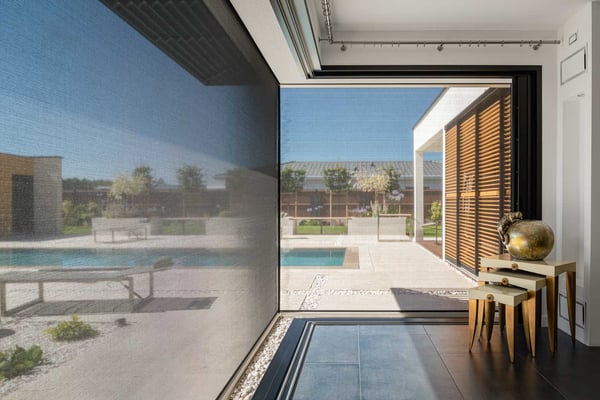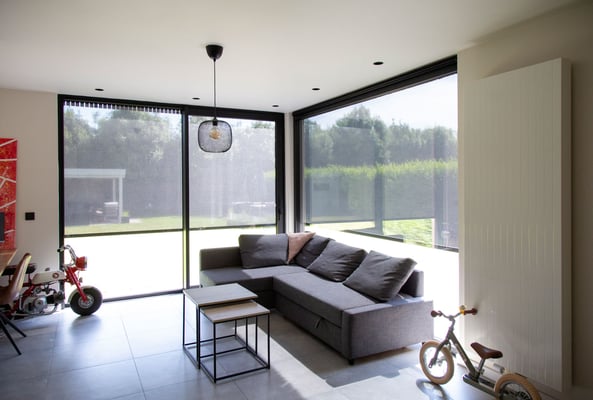What Fire Ratings does Approved Document B Require?
The 2022 edition of Approved Document B uses the European Reaction to Fire System (Euroclass). Euroclass is the European standard for assessing the ‘reaction to fire’ of construction products and is also used in the UK.
Using a series of defined tests, it categorises construction products into one of seven classes according to combustibility, ranging from A1 (least combustible) to F (most combustible).
Additional classification is also provided for smoke production (from s1 – little to no smoke – to s3 – lots of smoke), and flaming droplets/particles (from d0 – none to d2 – quite a lot).
The product being tested is given a classification according to its performance in the fire tests.
Euroclass ratings overlap with other British standards, including BS476 (the Surface Spread of Flame Test) and EN13501 (Contribution to Fire Test). For example, BS476 Class 1 (the highest rating) is equivalent to Euroclass B (very limited contribution to fire). However, BS476 does not have an equivalent for Euroclass A1 or A2.
Why Do Renson External Blinds Fall Under Approved Document B Regulations?
External roller blinds offer many benefits, which include complete solar shading and keeping homes cool without air conditioning. Thanks to the tough, UV-repelling fabric panel and external coverage, the sun’s rays cannot reach the glass of a window, which eliminates solar gains plus heat build-up.
As the name would suggest, Renson External blinds are covered by Approved Document B, as they are regarded as part of a building’s façade when installed.
Requirement B4, Regulation 7(2) states:
‘Subject to paragraph (3), building work shall be carried out so that materials which become part of an external wall, or specified attachment, of a relevant building are of European Classification A2-s1, d0 or A1 (classified in accordance with the reaction to fire classification).’
Paragraph 3(ha) further specifies:
[Paragraph 2 does not apply to]…’components associated with a solar shading device, excluding components whose primary function is to provide shade or deflect sunlight, such as the awning curtain or slats’.
So the components of the blind are not necessarily required to meet Euroclass A1 or A2, but the fabric panel of the blind does become part of the façade.
Requirement B4, Section 12.19 covers ‘solar shading devices’ (which includes blinds) says:
‘12.19 Regulation 7(2) requires that the curtain and or slats of solar shading devices in a relevant building (as defined in regulation 7(4)) achieve class A1 or A2-s1, d0. The curtain of solar shading devices cannot be classified as a membrane in accordance with regulation 7(3).
12.20 Solar shading devices installed up to 4.5m above ground level are not required to meet the requirements of regulation 7(2).’
So what does this mean?
Before you assume that external roller blinds cannot be used for your property, it’s essential to understand the details. The Document B legislation is focused mainly on tall residential buildings (taller than 18m). However, buildings between 11m (five storeys) and 18m (nine storeys) are not exempt.
For buildings under 11m, façade safety requirements are slightly different, as we explain below.
What Are Fire Ratings for External Blinds?
Included within Document B are a complete list of ratings for external blinds which can be applied to the Renson models. The ratings are as follows:
- For blinds installed up to 4.5m above ground level (ie up to 1 storey) - there is no requirement to meet this standard. This means for some single story dwellings or extensions, the rules are not applicable. The height of 4.5m is defined as the top standard limit for lower stories within Document B with anything higher being included in the category of escape routes, hence the increased regulation parameters.
- For blinds installed up to 11m above ground level (ie up to 5 storeys) - blinds must be rated to Euroclass B. It should also be noted that the rules within Document B cover domestic dwellings and commercial properties hence the wide range of heights that have been covered.
- For blinds installed more than 11m above ground level (5 storeys plus) - blinds must meet Euroclass A2 - limited combustibility, or A1 - non-combustible.
Do Renson Blinds Meet These Standards?
Yes and no. Renson fabrics are fire-rated to Class 1 of BS476 Part 7, which is equivalent to Euroclass B. This means Renson® external blinds can be installed safely to any building under 11m or five storeys in height.
This covers most residential properties, so you can specify Renson® external roller blinds for your clients knowing they are compliant with safety standards.
However, Renson® blinds cannot currently be specified for use on buildings taller than 11m (five storeys). This is because the fabrics are yet to be tested to the Euroclass A1 & A2 standards required by Approved Document B.*
To provide external shading to windows above 11m, we recommend an all-metal solution (such as brise-soleil), which has been tested to meet Euroclass A1 or A2.
*as of January 2024
How Can Kensington Systems Support You With External Blinds?
As experienced blind fitters and specification experts, we are familiar with recent legislation including Approved Document B, Part O overheating regulations and others. We can provide expert advice for your projects, technical information and assistance with technical aspects such as integrating blinds with home automation systems.
Our Part O compliant Renson external blinds collection can be made bespoke depending on different project needs. Offering a stylish solution to overheating, they make the perfect high-quality, but low-maintenance addition to buildings under 11m. To learn more, get in touch with our team.






